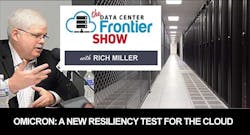The emergence of the Omicron variant of COVID-19 made headlines around the world over the past weekend. It’s not yet clear how serious Omicron may become, but it is a worrisome development in a pandemic that has extracted a high toll in death and disease around the world. But the prospect of another game-changing variant is already being felt in financial markets and global travel.
What might Omicron mean to the data center sector and cloud computing? That’s our topic today on the Data Center Frontier show, where we look at three areas of potential business impact: travel restrictions, supply chain disruptions, and the progress of the enterprise recovery in IT spending.
Important Note: Our podcast focuses on the data center business and cloud infrastructure, so if you’re seeking general healthcare information, please consult your medical professional or sources that specialize in health information. Here’s today’s discussion:
DCF Show 20: Omicron: A New Resiliency Test for the World and the Cloud
Listen to today’s show:
Here’s a timeline of topics discussed on the podcast:
- 1:45 – What we know, and don’t know, about the Omicron variant and its potential impact.
- 6:15 – The important role of data centers and cloud services during the COVID-19 pandemic.
- 6:50 – Data is global, and travel restrictions are a challenge for new deployments.
- 7:50- How travel restrictions could impact trade shows, conferences and in-person events.
- 10:20 – The state of the supply chain, and how data center operators are managing project delivery.
- 13:40 – The road ahead for the enterprise IT recovery.
Here are some resources discussed on the podcast:
- How Data Centers Are Navigating the Supply Chain Crisis: Data center operators have employed a variety of strategies to navigate supply chain pressures and line up equipment for construction projects. A dozen data center C-suite executives provide insights on the supply chain challenge and the industry’s response.
- COVID-19 Pandemic Drives Data Center Leasing to Record Heights: Data center customers have leased more than 500 megawatts of capacity in 2020, an all-time record. With space scarce in key markets, cloud platforms and video services are pre-leasing data centers before they are built.
Be sure to check our our free Annual Forecast, outlining the DCF take on the most important trends to watch this year:
DCF Roundtable: The Outlook for Resumption of Data Center Tours and In-Person Events
The new travel restrictions are certainly unwelcome news for trade show operators, who have by and large resumed in-person events after a lengthy period of being restricted to virtual events. One of the things that’s pretty clear is that many folks in the data center industry are really yearning to return to live events and want to make those new connections and see people face to face. There’s been a lot of feedback from the early events in the industry, Which have included the 7×24 Exchange’s global conference and a number of regional events, that people are really enjoying being able to to see one another and do business face-to face.
Perhaps the biggest challenge is for event operators that rely upon a global audience. The pandemic has been particularly difficult for these companies given all the travel restrictions, and that is likely to continue. But there have been some signs of success with hybrid events, including a couple of recent gatherings that includes the Open Compute Project as well as the Supercomputing21 event. These events had live in-person components – in San Jose for OCP and St Louis for SC21 – and at the same time They also served global audiences around the world virtually with applications and Zoom and video. This has shown that some of the challenges of the travel restrictions can be surmounted with the the right amount of technology.
There’s been a somewhat better outlook and more success for regional events. There have been a number of regional events for data center professionals that have gone very well and there’s been a lot of good feedback about them. However, that could also be at risk if we see cases emerge from the new variant within the United States, which would complicate air travel and make it more difficult for folks to get around and think about going back to events. It would also pose some challenges about what sort of restrictions and guidelines events operators need to impose to to keep their attendees healthy.
In both business and events, the lessons of the past couple of years will provide crucial strategies for managing through virtual channels and adapting operations to whatever business restrictions are in place and. As we’ve noted, the data center business continued to deliver new capacity throughout the pandemic – which brings us to the next topic that we are looking at today, which is supply chain issues.
Supply Chain Challenges
It’s no secret that the pandemic has made a mess of the global supply chain. We’ve all seen the stories about container ships stacked up in major ports and the challenges of moving products around the world to meet the the demands for not just data center construction, but also for servers and other components that are key to IT equipment. For most data center operators, managing the global supply chain crisis has been a function of leaning hard on their experience and relationships and getting even more obsessed than usual about planning.
How Data Centers Are Navigating the Supply Chain Crisis (Image: Shutterstock)
We covered this in a recent summary at Data Center Frontier on the state of the global supply chain. We listened in on a number of earnings calls for publicly held data center developers and data center equipment providers, and got perspectives from 12 different C-suite executives on how they are managing through the global supply chain crisis. We identified a number of strategies, which I will just mention here in passing, but in our show notes I’ll include a link to our story and you can read more about each of these strategies.
These include:
- Ordering equipment ahead of time.
- Holding more data center equipment inventory in warehouses and other locations where they can be quickly deployed to construction sites.
- Working with more suppliers, including new suppliers who can source hard to find products.
- Making spot purchases to meet specific short-term demand on particular items sometimes at premium prices. Supply and demand is is certainly in impacting the delivery time and and pricing on some of these components.
- Many folks have really been doubling down on their supplier relationships and wielding their size and financial strength to help ah make sure that they have the inventory they need to deliver on projects.
- And finally, just about everyone is working ahead on their forecasting and procurement for 2022, 2023 and beyond.
The toughest choke point for the supply chain will likely be in the semiconductor shortages, which have affected not just computers and servers, but also cars and kitchen appliances and any number of the many things that rely on chips throughout our global economy. If component availability continues to delay delay the deliveries of chips, servers and network gear, ultimately that will play into the the fill rates for data center capacity. When a developer delivers a data hall, that doesn’t necessarily mean that all the servers are just going to roll right in immediately (although we did see a bunch of that during the the COVID-19 pandemic). But that’s one area where the availability of chips and the timelines for when people can get new servers will have an impact on how quickly data center equipment is deployed.
Enterprise IT Spending
Finally, let’s talk about the enterprise spending recovery. If there’s one thing that markets hate it is unpredictability, and the unpredictability of the COVID-19 pandemic has been a major factor in the subdued investment that we’ve seen in it infrastructure by the enterprise sector during 2020. In the first year of the pandemic there was so much uncertainty and difficulty in sorting out what the future was going to look like. There’s significant anecdotal evidence that enterprise spending on data center services has begun to normalize and rebound in 2021. We’ve talked with a number of some of data center developers and service providers in recent months who say they’ve seen increased activity, and they expect that to lead to better enterprise sales for the year.
This is where Omicron raises questions about whether that trend will continue into 2022. The good news is that several years of operating through a pandemic has provided tools that can limit the uncertainty created by new variants. That includes the timeline on new vaccines. In the event that Omicron does prove to be difficult to treat with the current vaccines, pharmaceutical companies like Moderna and Pfizer and Johnson and Johnson are already in the lab. They have copies of Omicron and know what it looks like and are in the development phase for vaccine updates that could target the problematic elements of Omicron.
The executives from companies that use the mRNA technology, which has accelerated vaccine development for the original batch of COVID-19 vaccines, say that they believe that the process can help them hopefully develop new vaccines to address the particularities of Omicron within about 100 days, and then the issue would be how long the the approval and deployment process might take. Some analysts who have tracked vaccine development very closely suggests that if vaccine escape is a challenge with Omicron, that there could be widespread deployment of vaccines to address it as soon as the Summer of 2022, and perhaps even earlier. In theory, this could create a timeline that establishes an outer bound for worst-case scenarios.
But even for enterprises that are being careful with their spending because of concerns about COVID-19, there is a a clear mandate to be able to engineer their IT operations to handle whatever eventualities may come. The uncertainty now is how long we’ll see new variants. So long as you know vaccination continues to be reduced in some areas of the world. There’s going to be an ongoing risk that new variants will emerge, and they may require new travel restrictions or adjustments to vaccines, And so being able to just freeze operations in place and not adapt your IT infrastructure to be flexible to respond to whatever circumstances are presented by the pandemic really seems to be a less appealing option.
There’s been a lot of discussion about how the companies that have been the most successful during the pandemic have been the ones that have been able to prepare their IT operations to be flexible, using cloud colocation and on-premises capacity to address whatever needs come up, including the need to rapidly scale up remote work and networks to meet the needs of more video.
So on one hand, Omicron could be something that gives pause to folks who are making spending decisions for the enterprise sector, as it did in 2020. But there’s a whole other level on which life goes on – and the pandemic unfortunately seems to go on – and companies can’t wait forever to create more nimble infrastructures that can handle whatever digital transformation might look like in your organization. It’s really time to get on with it. So this will be a very important development to track. All eyes will be on the enterprise sector.
One thing is for sure – the demand for data center capacity will continue through 2022 through whatever uncertainties might be created by the Omicron variant, the course of the COVID-19 pandemic, or the many other business factors that are driving the digital transformation in which data centers are really remaking how our world does business, education, healthcare, and so many of our everyday activities.
Here at Data Center Frontier, we’ll be continuing to monitor all of these trends as we tell the story of the data center industry, one podcast at a time. Stay safe everybody and we’ll be back again soon.








